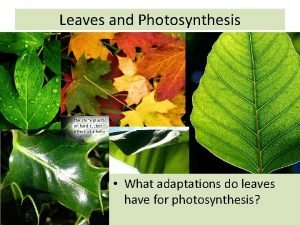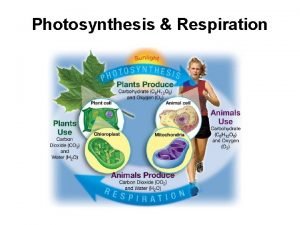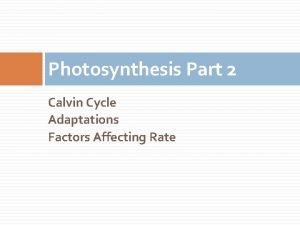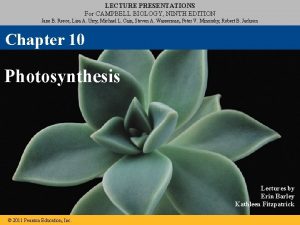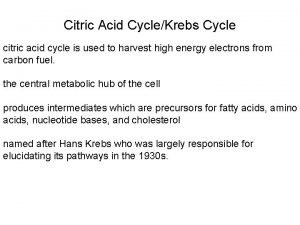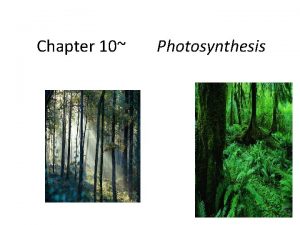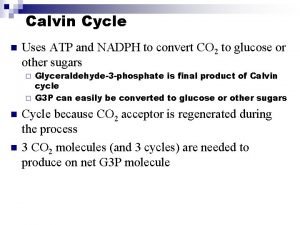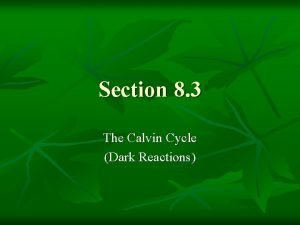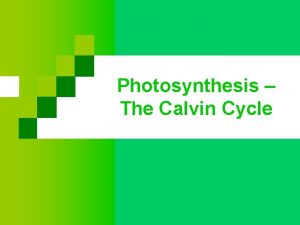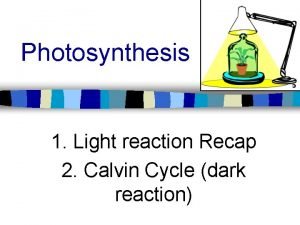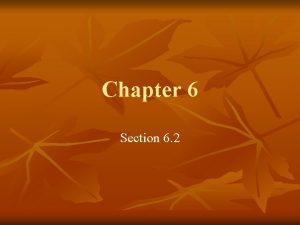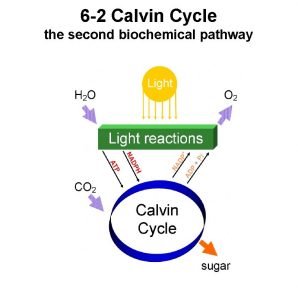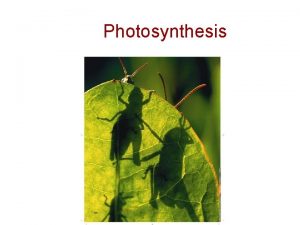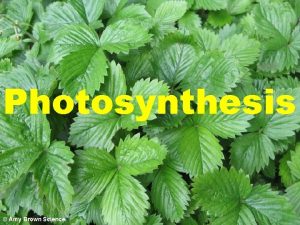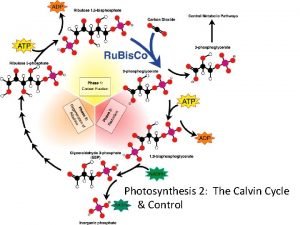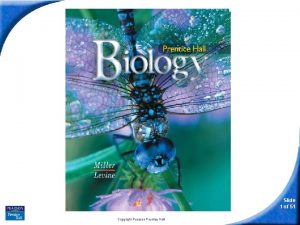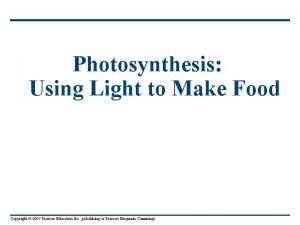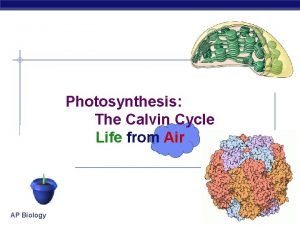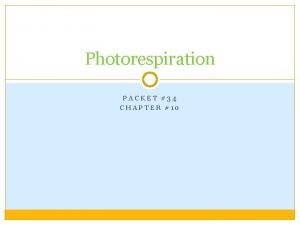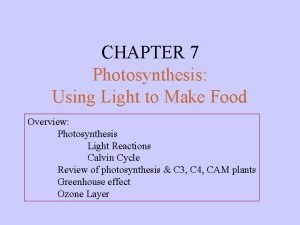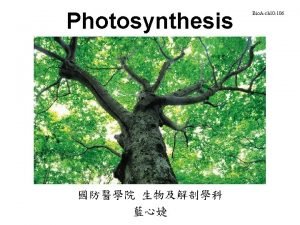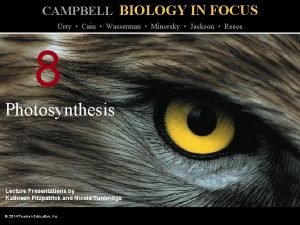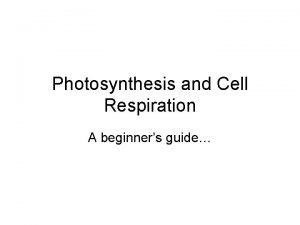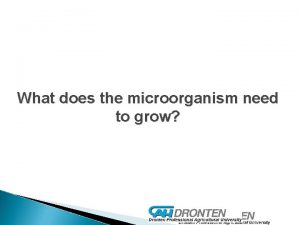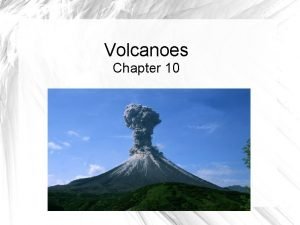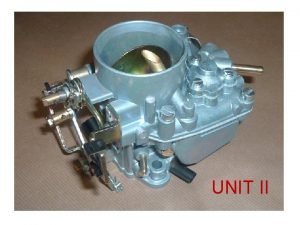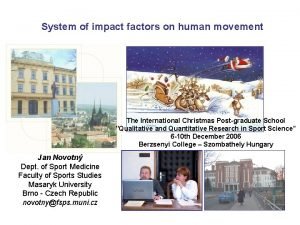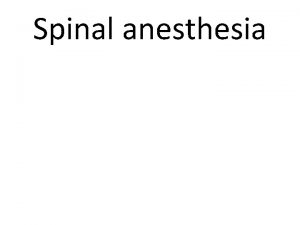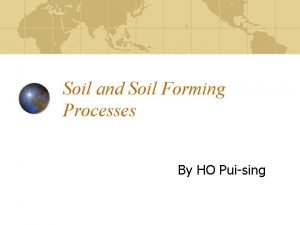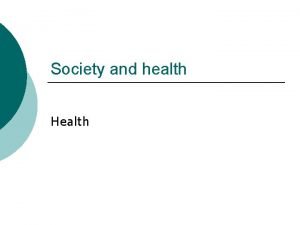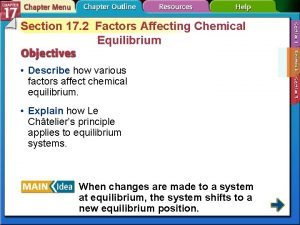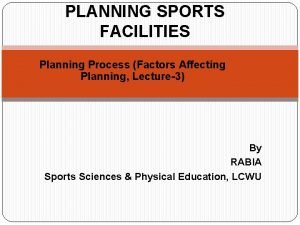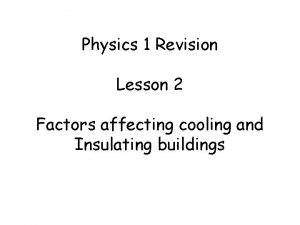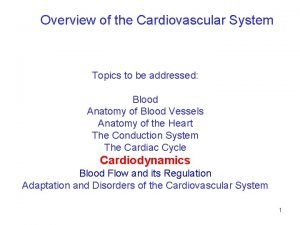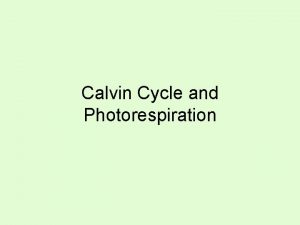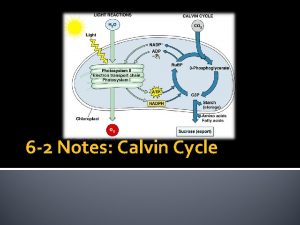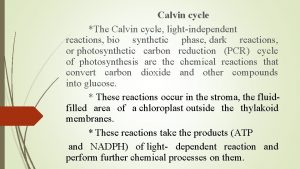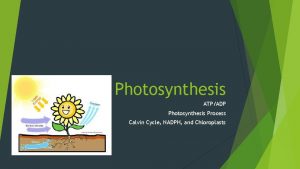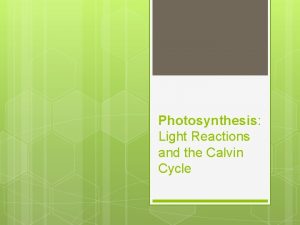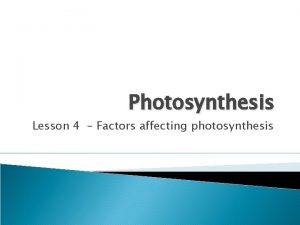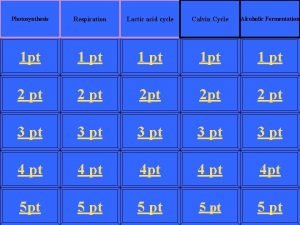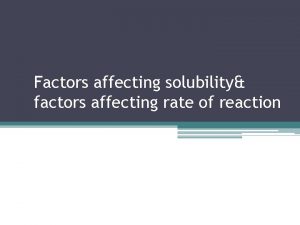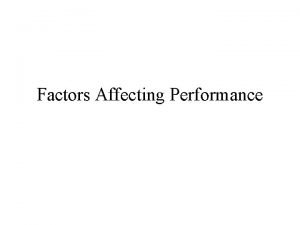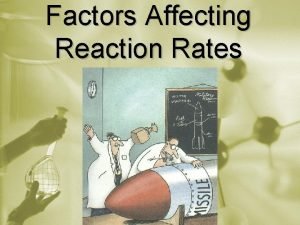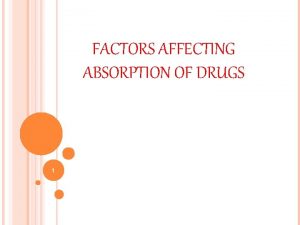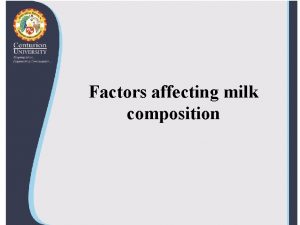Photosynthesis Part 2 Calvin Cycle Adaptations Factors Affecting


















































- Slides: 50

Photosynthesis Part 2 Calvin Cycle Adaptations Factors Affecting Rate

Calvin Cycle

Calvin cycle occurs in the stroma /Thylakoid space Intermembrane Space

Calvin Cycle Overview Cyclical process with 3 phases: Carbon fixation: incorporation of CO 2 Reduction: utilization of energy molecules to form organic compound Renegeration: regenerates molecules for another cycle

Calvin Cycle Overview

Phase 1: Carbon Fixation (3 -PGA or 3 PG) reaction type: synthesis enzyme: synthase (Rubisco) energy: absorbed CO 2 (1 c) + 1, 5 Ru. BP (5 c) = short lived 6 C intermediate 6 C molecule split into two 3 C molecule known as 3 -PGA/3 PG Above reaction occurs 3 x

Rubisco ribulose bisphosphate carboxylase / oxygenase large, slow reacting enzyme most enzymes process 1000 reactions / second rubisco processes 3 reactions / second plants need large amounts of rubisco for Calvin cycle half the protein in a leaf most abundant protein on Earth

Phase 2: Reduction

Calvin Cycle: Energy Utilization ATP phosphorylates each 3 -carbon molecule reaction type: phosphorylation enzyme: kinase energy: absorbed

Calvin Cycle: Energy Utilization NADPH used to synthesize G 3 P reaction type: redox enzyme: dehydrogenase energy: absorbed

Phase 3: Regeneration Of the 6 G 3 P produced 1 of them exits the cycle to eventually become glucose and other types of organic compounds The other 5 G 3 P continue in the cycle to help regenerate the starting substances

Phase 3: Regeneration

Calvin Cycle: Regenerate Molecules G 3 P resynthesized to 1, 5 Ru. BP 5 x 3 C (G 3 P) 3 x 5 C (Ru. BP) 15 C in total Uses ATP reaction type: synthesis enzyme: synthase energy: absorbed


Adaptations to Limitations Photorespiration limitations: C 3 plant Adaptations to hot, arid conditions: C 4 plants CAM plants

C 3 Plants whose first organic product of carbon fixation is a 3 -carbon compound C 3 plants undergo photosynthesis as described (3 -PGA or 3 PG)

C 3 Plants Stomata are open during the day / closed at night What happens to stomata in hot, arid conditions?

Stomata

C 3 Plant Limitations In hot, arid conditions, plants close the stomata to prevent water loss What affect does that have on CO 2 and O 2 concentration? http: //evolution. berkeley. edu/evolibrary/images/interviews/stoma_diagram. gif

C 3 Plant Limitations Closed stomata CO 2 decreases: Slows/stops Calvin cycle Closed stomata O 2 increases: rubisco binds to O 2 rather than CO 2 skip the Calvin cycle glucose is not produced

Rubisco 2 possible substrates: CO 2 or O 2 Carboxylase: binds CO 2 yields 2 x PGA Oxygenase: binds O 2 yields 1 x PGA and PG Photosynthesis X http: //ucce. ucdavis. edu/files/repository/calag/fig 6302 p 68 a. jpg

Rubisco Reaction http: //www. chemgapedia. de/vsengine/media/width/750/height/409/vsc/de/ch/8/bc/stoffwechsel/photosynthese/flash/rubisco_mech 8. svg. jpg

Phosphoglycollate (PG) cannot be converted directly into sugars is a wasteful loss of carbon to retrieve the carbon from it, plants must use an energy-expensive process called photorespiration

Photorespiration (aka photo-oxidation) “photo”: occurs in the light unlike photosynthesis, produces no organic fuel (no Calvin cycle) “respiration”: consumes oxygen (by rubisco) unlike cellular respiration, generates no ATP wastes energy and reducing power results in the production of dangerous reactive oxygen species (H 2 O 2) in the peroxisome

Why does photorespiration exist? Evolutionary baggage: Metabolic relic from earlier time when atmosphere had less O 2 and more CO 2 With so much CO 2, rubisco’s inability to exclude O 2 had little impact on photosynthesis Modern times: Rubisco’s affinity for O 2 has a negative impact on crop yields

C 3 Plants: Agricultural Crops Hot arid dry conditions are detrimental to C 3 plants These conditions have a negative impact for farmers and consumers of C 3 agricultural crops: rice, wheat, soy

Evolutionary Efficiency Atmospheric O 2 is 500 x higher than CO 2 Yet rubisco fixes on average 4 CO 2 for every O 2

Photosynthetic Adaptations 2 other plant types have adapted photosynthesis to dry, arid conditions: C 4 plants – spatial (structural) separation CAM plants – temporal (behavioural) separation

PEP Carboxylase Very high affinity for CO 2 Can fix carbon even when CO 2 levels decrease and O 2 levels rise PEP (3 C) + CO 2 OAA (4 C) OAA Malate pyruvate (3 C) + CO 2 Pyruvate PEP

C 4 Plants Preface the Calvin cycle with an alternate mode of carbon fixation that produces a 4 -carbon compound as their first organic product Agricultural C 4 crops: sugar cane, corn

C 4 Plant: Leaf Structure Bundle-sheath cells tightly packed around vascular bundle Mesophyll cells loosely arranged near the leaf surface

C 4 Plant Adaptation Calvin cycle confined to bundle-sheath cells Preceded by incorporating CO 2 into organic compounds in the mesophyll

C 4 Plant Adaptation CO 2 added to a 3 -carbon phosphoenolpyruvate (PEP) to form a 4 -carbon oxaloacetate (OAA)

C 4 Plant Adaptation 4 C compound is exported to bundle-sheath cells where it releases CO 2 and a 3 C pyruvate CO 2 is assimilated into the Calvin cycle by rubisco Pyruvate returns to the mesophyll cell to be converted back to PEP (3 C)

C 4 Plant Adaptation Mesophyll cells act as a CO 2 pump Keeps concentration of CO 2 in bundle-sheath cells high (and oxygen low) so that rubisco can bind CO 2


CAM Plants CAM: Crassulacean acid metabolism Succulent (water-storing) plants Example: cacti, pineapples

CAM Plant Adaptation Nighttime: Stomata open Take up CO 2 and added to a 3 -carbon PEP to form a 4 -carbon OAA Enzyme: PEP carboxylase Further converted to malate (malic acid) which is stored in vacuoles of mesophyll cells

CAM Plant Adaptation Daytime: Stomata closed Conserve water no CO 2 uptake Light reactions make ATP and NADPH CO 2 in organic acid stored in vacuoles from the night is released to run the Calvin cycle

CAM Plant Adaptation

CAM Plant Adaptation Nighttime: CO 2 incorporation into organic acids, stored in vacuole Daytime: Calvin cycle with energy from light reaction and CO 2 from night storage

C 4 and CAM Plants CO 2 is incorporated into organic intermediates before entering Calvin cycle C 4: initial carbon fixation separated structurally CAM: initial carbon fixation separated temporally

Factors Affecting Photosynthesis Light intensity Carbon dioxide concentration Temperature

Light Intensity Rate of Photosynthesis Photorespiration Light intensity Low-mid intensity: linear response Higher intensity: saturation due to other limiting factors in photosynthesis Highest intensity: photorespiration light compensation point: minimum light intensity at which the leaf shows a net gain of carbon http: //www 2. geog. ucl. ac. uk/~plewis/geogg 124/_images/chapin 1. png

Light Intensity factors contributing to saturation Rate at which photosynthesis is saturated is increased with temperature and CO 2 levels http: //image. tutorvista. com/content/nutrition/light-intensity. jpeg

CO 2 Concentrations Rate of Photosynthesis Low concentration: CO 2 diffusion limits rate High concentration: saturation due to other limiting factors in photosynthesis CO 2 concentration http: //www 2. geog. ucl. ac. uk/~plewis/geogg 124/_images/chapin 2. png

CO 2 Concentrations factors contributing to saturation Rate at which photosynthesis is saturated is increased with light intensity http: //images. tutorvista. com/content/photosynthesis/carbondioxide-concentration-c 3 -c 4 -species. jpeg

Temperature Cool coastal dune plant Antarctic Lichen Evergreen desert shrub Summeractive desert perennial Each type of plant has a temperature range where photosynthesis is optimal http: //www 2. geog. ucl. ac. uk/~plewis/geogg 124/_images/chapin 6. png

Temperature factors contributing to maximum rate of photosynthesis Increased CO 2 levels increases the maximal rate of photosynthesis http: //www. co 2 science. org/education/reports/extinction/figures/fig 1. jpg

Photosynthesis Rate Factors Factor Effect on Rate of photosynthesis Increase to a plateau (saturation) since Calvin cycle Light intensity reactions cannot keep up with light reactions Increase to a plateau since Calvin light reactions can not keep CO 2 levels cycle up with Calvin cycle Maximum rate can be Temperature increased by increasing CO 2
 Raw materials for photosynthesis
Raw materials for photosynthesis Inputs and outputs of calvin cycle
Inputs and outputs of calvin cycle Photosynthesis citric acid cycle
Photosynthesis citric acid cycle Calvin cycle
Calvin cycle Calvin cycle campbell
Calvin cycle campbell Inputs to the citric acid cycle
Inputs to the citric acid cycle Calvin cycle
Calvin cycle Calvin cycle
Calvin cycle What is the calvin cycle
What is the calvin cycle Calvin cycle
Calvin cycle Calvin cycle
Calvin cycle Section 6-2 the calvin cycle
Section 6-2 the calvin cycle 6-2 review the calvin cycle
6-2 review the calvin cycle Whats another name for the calvin cycle
Whats another name for the calvin cycle The calvin cycle occurs in the___________.
The calvin cycle occurs in the___________. Calvin cycle
Calvin cycle What happens in the calvin cycle
What happens in the calvin cycle Calvin cycle
Calvin cycle Photosynthesis
Photosynthesis Calvin cycle
Calvin cycle The calvin cycle constructs
The calvin cycle constructs Calvin cycle diagram
Calvin cycle diagram Aerobic respiration exercise
Aerobic respiration exercise Calvin cycle
Calvin cycle Limiting factors of photosynthesis graphs
Limiting factors of photosynthesis graphs Photosynthesis equation
Photosynthesis equation What are the factors affecting the climate
What are the factors affecting the climate Factors affecting microbial growth in food
Factors affecting microbial growth in food Factor affecting volcanic eruption
Factor affecting volcanic eruption Factors affecting volcanic eruption
Factors affecting volcanic eruption Nozzle lip is provided in simple carburettor
Nozzle lip is provided in simple carburettor Factors affecting tg curve
Factors affecting tg curve Factors affecting housing choices
Factors affecting housing choices Factors affecting the success of multilingualism
Factors affecting the success of multilingualism Human movement science impact factor
Human movement science impact factor Ejection fraction vs stroke volume
Ejection fraction vs stroke volume Factors affecting movement in physical education
Factors affecting movement in physical education Baricity definition
Baricity definition Eluviation vs illuviation
Eluviation vs illuviation Factors affecting health
Factors affecting health Explain the factors affecting chemical equilibrium
Explain the factors affecting chemical equilibrium Factors affecting sample size
Factors affecting sample size Factors affecting the merchandising function
Factors affecting the merchandising function Factors that affect the planning process
Factors that affect the planning process Factors affecting rate of cooling
Factors affecting rate of cooling Factors that affect sports performance
Factors that affect sports performance Psychological factors affecting sports performance
Psychological factors affecting sports performance Advantages and disadvantages of drugs
Advantages and disadvantages of drugs Cardiac output is determined by
Cardiac output is determined by Factors affecting transportation decisions
Factors affecting transportation decisions Factors affecting span of control
Factors affecting span of control
